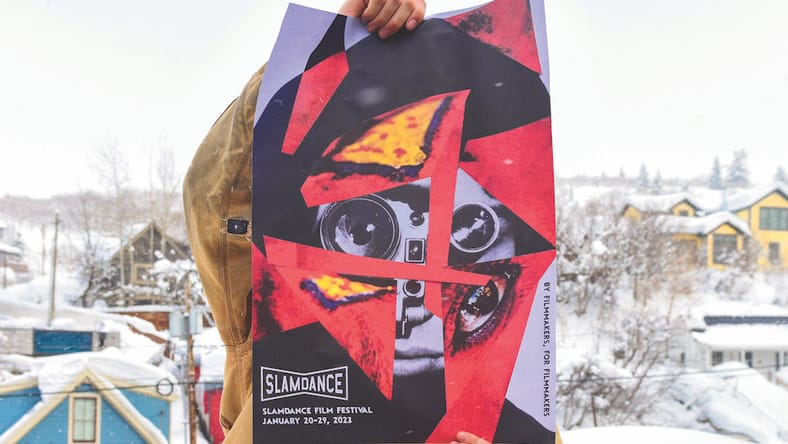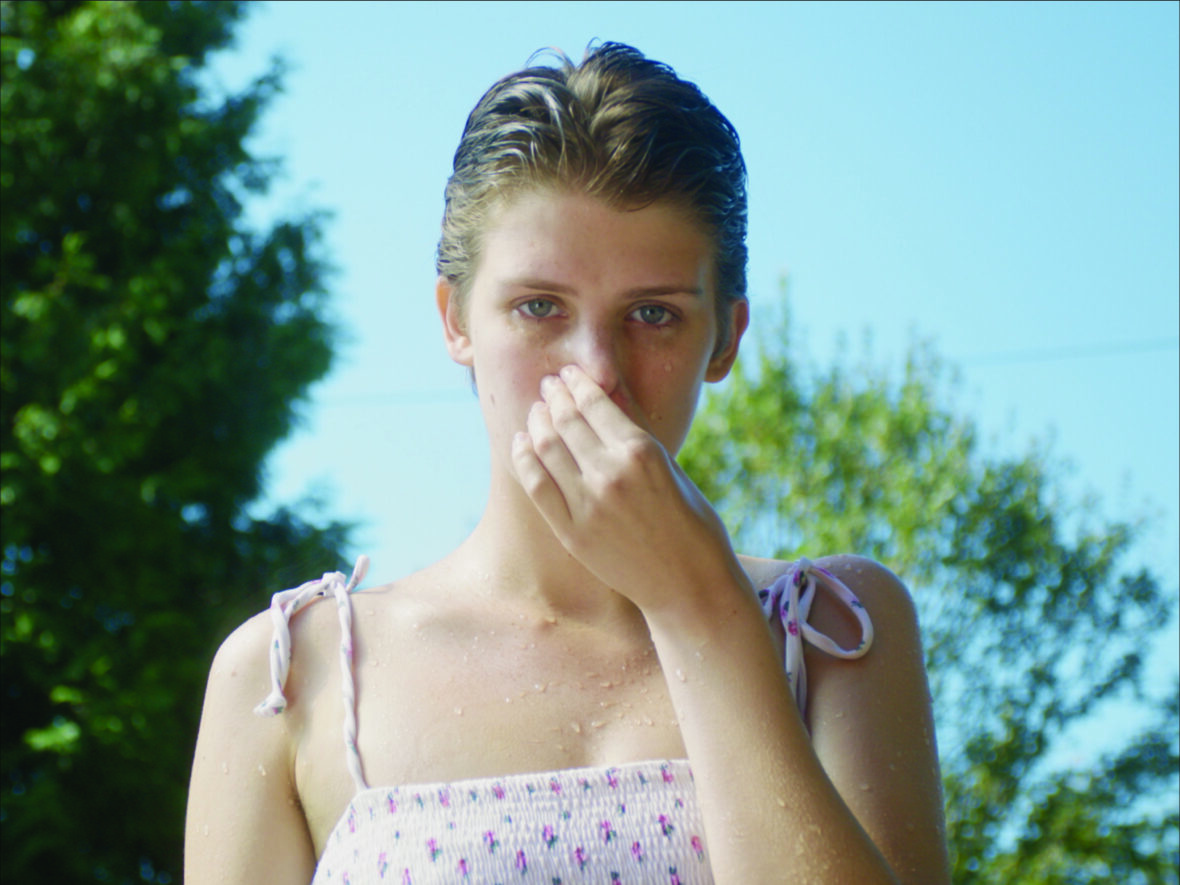
Peter Baxter is the co-founder of Slamdance, one of the most revered film festivals of all. In this piece, he shares his answer to the question, “How do I get into Slamdance?”
Every year I’m asked this question. Since we started Slamdance in 1995, you might think by now my answer would be concise and direct, but it’s not. This is a gateway question into the world of Slamdance, its collective experience and ongoing experimentation, as organized by artists. To answer it, join me on a visit to the Slamdance house and meet the occupants who are its heart and soul.
First, meet the dissidents, also known as alumni. Slamdance has sometimes been called an institution, but that’s not the case. This implies its members follow rules and acceptable opinion. Alumni are not obedient, passive, or quietly accepting, and some do not even want to be called a member. Our alumni are the Slamdance programmers — filmmakers who’ve previously shown their work at the festival — and now shape it for new artists to come.
Also Read: 50 Film Festivals Worth the Entry Fee in 2023
This is where the Slamdance slogan “by filmmakers, for filmmakers” comes from. Only alumni decide what gets into the festival. No manager, agent, attorney — no festival director — no one interferes with their collective decision making. They are rule breakers, radical and diverse thinkers and the sole recipients of your film entry.
They’re looking for kindred spirits — filmmakers who dared to create, like them, something new, something true. I’ve been here long enough to safely say they fulfill — purely — their own creative expectation and no one else’s.
You can see how this direction unfolded from Slamdance’s beginning with single-minded filmmakers like Chris Nolan, Anthony and Joe Russo, and Lisa Yu, and continues on into the present with filmmakers like Merawi Gerima, Ethan Eng and Hannah Peterson. None play creation safely.

Programmers choose which category of film they will be reviewing and form programming teams supported by co-captains. From here, every programmer has the same vote and say on deciding which film gets into Slamdance. “Say” is a big thing for us. We don’t just watch films, score them and send in comments for some higher authority to take over. All programmers who have watched a certain amount of films attend the final meetings to decide the year’s lineup and contribute to a torrent of passionate debate that often determines consensus amongst the programming team in deciding a film.
In the Narrative Shorts category, programmer and co-captain Brian Ratigan describes a Slamdance film as being “original, innovative, from an unheard voice, that may not fit into the mainstream festival circuit and allows independent cinema to be absorbed by fresh eyes.”
Brian’s comments were brought to life by this year’s AGBO Fellowship winner, Lollygag, by Tij D’Oyen. As Chief Creative Officer Angela Russo-Otstot says, D’Oyen “expertly crafts a bold and original cinematic piece, showcasing himself as a unique visionary.” His film was programmed out of more than 5,000 short film entries.
The DIY Salon des Refusés
The Narrative Features program for new directors started out as a program of American-made features, all of which were rejected by Sundance. Our DIY version of the Salon des Refusés struck a chord with the film industry, and soon, films here were finding distribution. The Daytrippers, directed by Greg Mottola and produced by Steven Soderbergh, won our first Jury prize and went on to find international acclaim at Cannes and Toronto, and global distribution.
Today, the program has a strong track record of discovering filmmakers from all over the world who go on to shape the future of cinema. Parasite director Bong Joon-ho’s first film premiered at Slamdance.
Narrative Features program co-captain and programmer Mila Zuo says: “We’re looking for films not only with innovative aesthetics that push the boundaries of global cinematic language, but which are also saying something meaningful about what it means to be alive in today’s world. In terms of programming for Slamdance, this means looking for spirited films that possess a social conscience and which tell stories that urgently need to be shared.”
Skinner Myers, another co-captain and programmer who won the 2021 narrative feature Grand Jury Award with his groundbreaking The Sleeping Negro, adds: “Our aim is to find films that approach cinematic storytelling in a radical way and add to the cinematic tradition.”
What if you’re not a first-time filmmaker? Our Breakouts section programs experienced directors who have developed a distinct visual style and unique cinematic voice. I asked Kyra Rogers, a programmer in Breakouts, for her thoughts on how to get a film into Slamdance.
“When an artist has the courage to reveal something… to be vulnerable enough to reveal something true, that’s a Slamdance film – a shackles-off approach to filmmaking and life. Slamdance is different from the other major festivals because it’s artist-run. We don’t care about ‘the market’ and we want transgressive movies and their dissident creators. Too much art is run by businesses and algorithms. We’re here as a bastion for those who know the real power that art holds.”
At Slamdance this year, we premiered Starring Jerry as Himself, directed by Law Chen, and it won both the Audience Award and the Grand Jury Prize in the Documentary Features program. The jury called the film a “provocatively crafted, tightly wound suspense tale that feels like solving a shape-shifting puzzle.
Jerry is both target and orchestrator in this rare form of documentary involving his entire family, who seek to make sense of the absurd events that have upended their seemingly secure lives.”
Part of this shape-shifting tale involved the filmmaker challenging the audience to go between what is actually documentary or narrative filmmaking. It was a spectacular direction to take… courageous and graceful, too. Law said he was aware while making the film that his experimental production might fall off a cliff at any moment. But, it didn’t. The creative risks paid off brilliantly.
“In selecting Slamdance documentary features, we are looking for pioneering voices telling stories from the underbelly, created for underserved audiences that will make an impact in the world,” says programmer and co-captain Summer Garber. Starring Jerry as Himself does all of these things.

Pioneering filmmaking voices also build new programs. Following a letter from filmmaker Juliet Romeo in 2019, Slamdance began a new program called Unstoppable, a showcase of films made by filmmakers with visible and non-visible disabilities. Programmed exclusively by disabled artists, Unstoppable aims to eliminate the prejudices and gatekeeping that have historically kept disabled filmmakers from being represented in the entertainment industry.
Longtime programmer and Unstoppable co-captain Beth Prouty says the programming team is looking for “authentic and honest stories that need to approach any disabled characters or subjects with respect. If you’re making a film about someone with a certain condition or disability, assume that someone with that same condition may be watching and reviewing the film.” Our first Unstoppable program showcased an eventual Oscar nominee, “Feeling Through,” by Doug Roland.
Slamdance programmers inherently understand the DIY filmmaking process. We have lived and continue to live it. Our Animation, Episodes and Experimental programs go to the heart of do-it-yourself filmmaking, and we’re passionate about supporting the singular nature of creators who work in these genres.
When I asked Experimental programmer Lori Felker, whose short film “Continuity”played at Slamdance in 2016, what she looks for in selecting a film, she first pointed out: “We are not gatekeepers. We are you. We get it.” She continued: “After I watch a film, I immediately ask myself if I feel like I want to tell someone else about it. So many films are great, solid, and successful, but I don’t want to tell my mom or my partner or buddy about it.
“Some films, however, make me want to run home and shout out about what I just saw. Redefine a category, take a risk, and try something new. The more unique your vision, the more likely we’re going to notice it.”
Lori’s response reminds me of the creative bedlam that is the Department of Anarchy, a short film program presented at different times of the year on the Slamdance Channel. The casual cinephile might associate the Department of Anarchy with avant-garde, transgressive, or underground cinema. It is all of these things and none of them. Curators Noel Lawrence and Burke Roberts like to think of Anarchy as “an anti-genre.”
Anarchy Films are innovative in form and provocative in purpose. Some will make viewers feel as though they’ve been dosed with LSD. Others are a reflection upon the terrors and tragedies of the human condition. Still others are the darkest of comedies that may (or may not) include goblin fellatio.
Anarchy filmmakers are the black sheep of the cinematic herd. Their films are not produced for the entertainment industry — you can say they’re produced in spite of the entertainment industry. This ongoing curation gives a platform to cutting-edge works that subvert the status quo — subconsciously, politically, sexually, stylistically and commercially. They are diverse in every respect.
“If your short seems experimental, ‘super artsy,’ or just seems to live outside of a traditional genre because of strange or innovative structural devices, or if it pushes taboos and/or deals with transgressive political, psychological, sexual or violent content, this may well be an Anarchy film,” says Noel.
Slamdance sets no submission limits on the type of film you think you’ve made. We are open to any moving-image sequence and the future possibilities of storytelling. This is why we started DIG (Digital, Interactive & Gaming).
DIG recognizes creators who are using new and emerging mediums. “We have very few limits on the kinds of work we’ll consider, because as programmers we understand that the future of storytelling has no boundaries,” says multi-disciplinary artist Dekker Dreyer.
Slamdance Success Stories
In the summer of 2020, Amazon Studios released the Slamdance film The Vast of Night, directed by Andrew Patterson. At the point of distribution, the film had won global acclaim.
In Film Comment, Amy Taubin called it “a display of visionary moviemaking intelligence equal to that of my most memorable Utah experiences; Richard Kelly’s Donnie Darko or Shane Carruth’s Primer or for that matter, Christopher Nolan’s Following, which also premiered at Slamdance.”
The New York Times’ Manola Dargis said The Vast of Night is a “small-scale movie that flexes plenty of filmmaking muscle.” The Observer film critic Mark Kermode wrote that “Patterson works low-budget wonders in his audacious feature debut… the eerie night-time is lent a cutting-edge modernity by careful choreographed kinetic camerawork that takes your breath away.” Steven Soderbergh sent a text message describing the film more simply: “Whoa!”
The headline of the film’s New York Times review, “The Vast of Night: There’s More to Fear Than Fear Itself,” reflects the sense of overcoming fear, a challenge we must face in order to create something new. It’s about capturing the spirit of DIY filmmaking and a rallying cry for our community. It’s about a personal willingness to fall down in order to push filmmaking boundaries.
David Bowie once said, “If you feel safe in the area that you’re working in, you’re not working in the right area. Always go a little further into the water than you feel you’re capable of being in… go out of your depth, and when you feel your feet aren’t quite touching the bottom, you’re just about in the place of doing something exciting.” This is the Slamdance filmmaker zone. It is made possible by all of our programmers who themselves have felt their toes leave the bottom.
If you want to get into Slamdance, take your filmmaking to the edge. All the best!
Submissions for Slamdance open soon.

